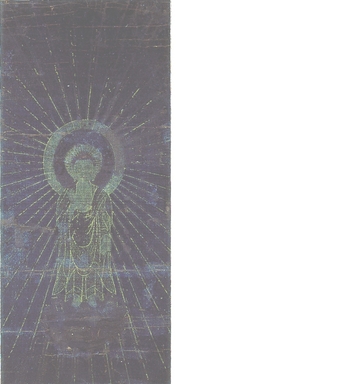
Medium: Color and gold on silk, mounted on a panel
Geograhical Locations:
Dates:15th century
Dimensions: 13 3/4 × 6 5/16 in. (35.0 × 16.0 cm)
Collections:
Accession Number: 2019.42.7
Image: CUR.2019.42.7.jpg,
Catalogue Description: Vertical painting, originally a hanging scroll, with a standing Buddha painted in gold on a dark blue ground. The Buddha has one hand raised in a gesture of reassurance and teaching, the other lowered with palm out in a gesture of wish granting. He stands on a lotus, which is now largely effaced. The Buddha is haloed and has forty-eight rays of light emanating from his body. The skin of the figure is rendered in stippled gold and any other pigment that may have been on the painting has worn away, including most of the Buddha's facial features. The size and subject of the painting suggest that it was originally displayed in a domestic shrine, possibly as the central panel of three. The 48 rays surrounding the figure suggest that it is Amida / Amitabha, the Buddha worshipped by adherents of the Pure Land School of Buddhism. The 48 rays represent the 48 vows taken by Amida in a previous life, when he was the monk Dharmakara, in which he promises to create a paradisical Buddha-land into which the faithful might be reborn in order to facilitate their quest for enlightenment. Amida is often represented as if he is descending from that paradise to retrieve the faithful as they pass out of the terrestrial world. The use of only gold to render the Buddha against the dark blue "void" suggests that this may be a representation of the "Formless Ultimate Buddha Body" of Amida, meaning the true, unseeable, transcendent aspect of the Buddha, as opposed to the visible, limited form of the Buddha, which he assumes as a favor to his disciples. The tradition of painting gold on a blue ground has its origins in Korean Buddhist manuscript illustration. Some of the gold in this painting appears to have been applied as cut leaf, rather than painted on.